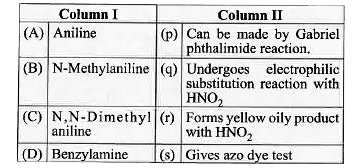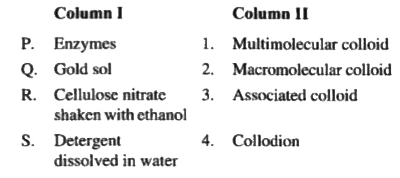Match the entries of column I with appropriate entries of coloumn II and choose the correct option out of the four options (a), (b), (c) and (d) given at the end of each question.
Column IColumn II(A)Helium(p)Ionization energy comparable toO2(B)Argon(q)Provides inert atmosphere in metallurgy(C)Neon(r)Cryogenic(D)Xenon(s)Advertising sign
A-q, B-s, C-p, D-r
A-q, B-p, C-s, D-r
A-r, B-q, C-s, D-p
A-r, B-s, C-q, D-p
The correct Answer is:C
To solve the problem of matching the entries in Column I with those in Column II, we will analyze each entry in Column I and find the most suitable match from Column II based on the properties and uses of the noble gases.
1. Identify the entries in Column I:
- A: Helium
- B: Argon
- C: Neon
- D: Xenon
2. Identify the entries in Column II:
- p: Ionization energy comparable to O₂
- q: Provides inert atmosphere in metallurgy
- r: Cryogenic
- s: Advertising sign
3. Match Helium (A):
- Helium is known for its use in cryogenics, particularly in cooling superconducting magnets. Therefore, it matches with r: Cryogenic.
- Match: A → r
4. Match Argon (B):
- Argon is commonly used to provide an inert atmosphere in processes like welding and metallurgy to prevent oxidation. Thus, it matches with q: Provides inert atmosphere in metallurgy.
- Match: B → q
5. Match Neon (C):
- Neon is widely used in advertising signs due to its ability to emit light when an electric current passes through it. Hence, it matches with s: Advertising sign.
- Match: C → s
6. Match Xenon (D):
- Xenon has an ionization energy that is comparable to that of oxygen, which is significant in various chemical reactions. Therefore, it matches with p: Ionization energy comparable to O₂.
- Match: D → p
7. Final Matches:
- A → r (Helium → Cryogenic)
- B → q (Argon → Provides inert atmosphere in metallurgy)
- C → s (Neon → Advertising sign)
- D → p (Xenon → Ionization energy comparable to O₂)
Conclusion:
The correct matches are:
- A with r
- B with q
- C with s
- D with p
Thus, the correct option based on the matches is (c).
- A: Helium
- B: Argon
- C: Neon
- D: Xenon
- p: Ionization energy comparable to O₂
- q: Provides inert atmosphere in metallurgy
- r: Cryogenic
- s: Advertising sign
- Helium is known for its use in cryogenics, particularly in cooling superconducting magnets. Therefore, it matches with r: Cryogenic.
- Match: A → r
- Argon is commonly used to provide an inert atmosphere in processes like welding and metallurgy to prevent oxidation. Thus, it matches with q: Provides inert atmosphere in metallurgy.
- Match: B → q
- Neon is widely used in advertising signs due to its ability to emit light when an electric current passes through it. Hence, it matches with s: Advertising sign.
- Match: C → s
- Xenon has an ionization energy that is comparable to that of oxygen, which is significant in various chemical reactions. Therefore, it matches with p: Ionization energy comparable to O₂.
- Match: D → p
- A → r (Helium → Cryogenic)
- B → q (Argon → Provides inert atmosphere in metallurgy)
- C → s (Neon → Advertising sign)
- D → p (Xenon → Ionization energy comparable to O₂)
The correct matches are:
- A with r
- B with q
- C with s
- D with p
Topper's Solved these Questions
- P-BLOCK ELEMENTS Book:PRADEEPChapter:P-BLOCK ELEMENTS Exercise:ASSERTION AND REASON TYPE QUESTIONS
Explore 6 Videos
- P-BLOCK ELEMENTS Book:PRADEEPChapter:P-BLOCK ELEMENTS Exercise:LONG ANSWER QUESTIONS
Explore 8 Videos
- P-BLOCK ELEMENTS Book:PRADEEPChapter:P-BLOCK ELEMENTS Exercise:SHORT ANSWER QUESTIONS
Explore 101 Videos
- ORGANIC COMPOUNDS CONTAINING NITROGENBook:PRADEEPChapter:ORGANIC COMPOUNDS CONTAINING NITROGENExercise:IMPORTANT QUESTIONS FOR BOARD EXAMINATION
Explore 27 Videos
- POLYMERSBook:PRADEEPChapter:POLYMERSExercise:IMPORTANT Questions (For Board Examination)
Explore 27 Videos
Similar Questions
Knowledge Check
Match the entries of column I with appropriate entries of column II and choose the correct option.
 AA-s, B-r, C-q, D-pBA-q, B-s, C-p, D-rCA-r, B-p, C-s, D-qDA-p, B-q, C-r, D-s
AA-s, B-r, C-q, D-pBA-q, B-s, C-p, D-rCA-r, B-p, C-s, D-qDA-p, B-q, C-r, D-sMatch the entries of Column I with appropriate entries of Column II and select the correct option.
 AP-1, Q-2, R-3, S-4BP-2, Q-3, R-4, S-1CP-2, Q-1, R-4, S-3DP-3, Q-2, R-1, S-4
AP-1, Q-2, R-3, S-4BP-2, Q-3, R-4, S-1CP-2, Q-1, R-4, S-3DP-3, Q-2, R-1, S-4Match the entries of column I with appropriate entries of column II and choose the correct option out of the four option (a), (b), (c), (d) given at the end of each question.
Column IColumn II(A) femto(p) 109(B) yotta(q) 10−15(C) giga(r) 10−18(D) atto(s) 1024AA-q, B-p, C-r, D-sBA-s, B-q, C-p, D-rCA-q, B-s, C-p, D-rDA-r, B-s, C-p, D-q
Match the entries of column I with appropriate entries of column II and choose the correct option but of the four options (a), (b), (c ), (d) given at the end of each question.
Column IColumn II(A)Siderite(p)Zinc(B)Chalcocite(q)Aluminium(C)Calamine(r)Copper(D)Bauxine(s)Iron
View SolutionMatch the entries of column I with appropriate entries of coloumn II and choose the correct option out of the four options (a), (b), (c) and (d) given at the end of each question.
Column IColumn II(A)PCl5(p)Angular(B)IF7(q)Pyramidal(C)H3O+(r)Trigonal bipyramidal(D)ClO2(s)Pentagonal bipyramidal
View SolutionMatch the entries of Column I with appropriate entries of Column II and chose the correct option out of the four options (a), (b), (c ) and (d) given at the end of each question.
Column IColumn II(A) Chlorine(p) Transition element(B) Helium(q) Highest electron gain enthalpy(C ) Iron(r ) Highest ionization enthalpy(D) Lithium(s) Strongest reducing agent
View SolutionMatch the entries of column I with appropriate entries of column II and choose the correct option but of the four options (a), (b), (c ), (d) given at the end of each question.
Column IColumn II(A)Zone refining(p)Titanium(B)Mond's process(q)Lead(C)Liquation(r)Nickel(D)van - Arkel(s)Germanium
View SolutionMatch the entries in column I with those in column II and choose the correct combination from the options given :

View Solution



